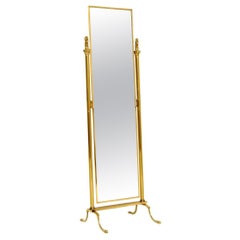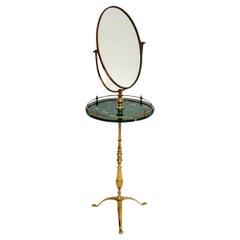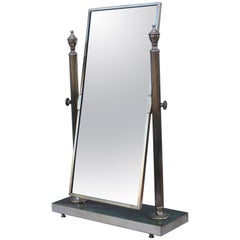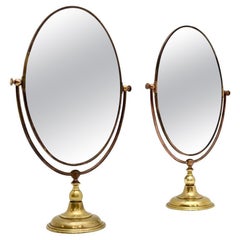Peerage Mirror
Vintage 1960s British Neoclassical Floor Mirrors and Full-Length Mirrors
Brass
Vintage 1960s British Mid-Century Modern Vanities
Brass
Recent Sales
20th Century American Mid-Century Modern Table Mirrors
Brass
Vintage 1960s British Mid-Century Modern Table Mirrors
Brass
Late 20th Century Unknown Mid-Century Modern Floor Mirrors and Full-Leng...
Brass
Mid-20th Century English Mid-Century Modern Table Mirrors
Brass
Mid-20th Century English Neoclassical Floor Mirrors and Full-Length Mirrors
Brass
People Also Browsed
Vintage 1960s Italian Directoire End Tables
Brass
Vintage 1960s American Mid-Century Modern Armchairs
Stainless Steel
2010s American Modern Screens and Room Dividers
Hardwood
2010s Brazilian Other Benches
Upholstery, Cord, Wood, Hardwood
Antique Late 19th Century Caucasian Kazak Caucasian Rugs
Wool, Natural Fiber, Organic Material
Vintage 1970s Mid-Century Modern Chairs
Paper
Antique Early 19th Century Swedish Gustavian Armchairs
Wood
2010s Brazilian Chairs
Cord, Wood, Hardwood
Antique Early 1900s French Art Nouveau Vases
Ceramic, Faience, Majolica
Late 20th Century Italian Modern Decorative Boxes
Metal
Vintage 1960s Italian Hollywood Regency Stools
Iron
Vintage 1910s English Neoclassical Dinner Plates
Porcelain
Vintage 1960s Danish Scandinavian Modern Sofas
Velvet, Beech
Antique 19th Century French Rococo Screens and Room Dividers
Giltwood
Early 20th Century Egyptian Revival Stools
Brass, Iron
21st Century and Contemporary French Art Deco Chandeliers and Pendants
Bronze
Materials: Brass Furniture
Whether burnished or lacquered, antique, new and vintage brass furniture can elevate a room.
From traditional spaces that use brass as an accent — by way of brass dining chairs or brass pendant lights — to contemporary rooms that embrace bold brass decor, there are many ways to incorporate the golden-hued metal.
“I find mixed metals to be a very updated approach, as opposed to the old days, when it was all shiny brass of dulled-out silver tones,” says interior designer Drew McGukin. “I especially love working with brass and blackened steel for added warmth and tonality. To me, aged brass is complementary across many design styles and can trend contemporary or traditional when pushed either way.”
He proves his point in a San Francisco entryway, where a Lindsey Adelman light fixture hangs above a limited-edition table and stools by Kelly Wearstler — also an enthusiast of juxtapositions — all providing bronze accents. The walls were hand-painted by artist Caroline Lizarraga and the ombré stair runner is by DMc.
West Coast designer Catherine Kwong chose a sleek brass and lacquered-parchment credenza by Scala Luxury to fit this San Francisco apartment. “The design of this sideboard is reminiscent of work by French modernist Jean Prouvé. The brass font imbues the space with warmth and the round ‘portholes’ provide an arresting geometric element.”
Find antique, new and vintage brass tables, case pieces and other furnishings now on 1stDibs.
Finding the Right Mirrors for You
The road from early innovations in reflective glass to the alluring antique and vintage mirrors in trendy modern interiors has been a long one but we’re reminded of the journey everywhere we look.
In many respects, wall mirrors, floor mirrors and full-length mirrors are to interior design what jeans are to dressing. Exceedingly versatile. Universally flattering. Unobtrusively elegant. And while all mirrors are not created equal, even in their most elaborate incarnation, they're still the heavy lifters of interior design, visually enlarging and illuminating any space.
We’ve come a great distance from the polished stone that served as mirrors in Central America thousands of years ago or the copper mirrors of Mesopotamia before that. Today’s coveted glass Venetian mirrors, which should be cleaned with a solution of white vinegar and water, were likely produced in Italy beginning in the 1500s, while antique mirrors originating during the 19th century can add the rustic farmhouse feel to your mudroom that you didn’t know you needed.
By the early 20th century, experiments with various alloys allowed for mirrors to be made inexpensively. The geometric shapes and beveled edges that characterize mirrors crafted in the Art Deco style of the 1920s can bring pizzazz to your entryway, while an ornate LaBarge mirror made in the Hollywood Regency style makes a statement in any bedroom. Friedman Brothers is a particularly popular manufacturer known for decorative round and rectangular framed mirrors designed in the Rococo, Louis XVI and other styles, including dramatic wall mirrors framed in gold faux bamboo that bear the hallmarks of Asian design.
Perhaps unsurprisingly, mid-century modernism continues to influence the design of contemporary mirrors. Today’s simple yet chic mantel mirror frames, for example, often neutral in color, owe to the understated mirror designs introduced in the postwar era.
Sculptor and furniture maker Paul Evans had been making collage-style cabinets since at least the late 1950s when he designed his Patchwork mirror — part of a series that yielded expressive works of combined brass, copper and pewter — for Directional Furniture during the mid-1960s. Several books celebrating Evans’s work were published beginning in the early 2000s, as his unconventional furniture has been enjoying a moment not unlike the resurgence that the Ultrafragola mirror is seeing. Designed by the Memphis Group’s Ettore Sottsass in 1970, the Ultrafragola mirror, in all its sensuous acrylic splendor, has become somewhat of a star thanks to much-lauded appearances in shelter magazines and on social media.
On 1stDibs, we have a broad selection of vintage and antique mirrors and tips on how to style your contemporary mirror too.



